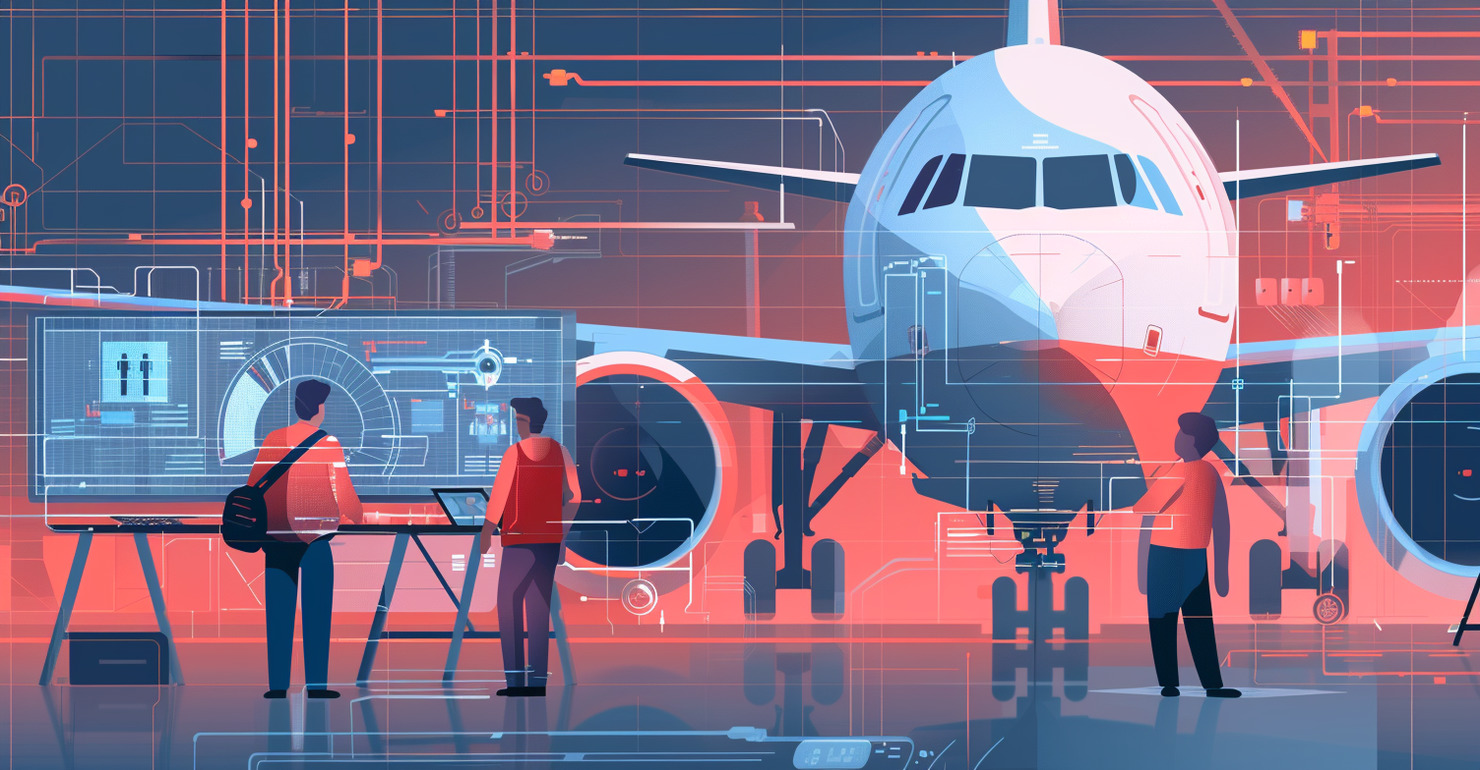
The Role of Artificial Intelligence in Reducing Aviation’s Carbon Footprint
Artificial intelligence (AI) technology is becoming increasingly important in tackling the urgent issue of reducing aviation’s carbon footprint. With the aviation industry facing sustainability goals and emission reduction targets, AI-powered solutions offer innovative ways to enhance fuel efficiency, optimize operations, and minimize environmental impact.
The impact of carbon emissions on the environment cannot be ignored. The rise in atmospheric carbon dioxide concentrations has disrupted the natural balance of the Earth’s layers and caused ecological and environmental effects such as climate zone changes, ecosystem evolution, and ocean acidification. It is vital to address these changes by implementing sustainable practices and technologies.
AI can play a crucial role in forecasting and reducing emissions. Predictive AI models analyze historical data, weather conditions, and flight routes to predict future emissions and assist in developing effective reduction strategies. By understanding and predicting emissions across an organization’s carbon footprint, companies can make informed decisions and take proactive measures to mitigate their impact.
Additionally, optimization techniques for AI training can significantly contribute to reducing its carbon footprint. By optimizing the training of deep learning models, energy consumption can be reduced by up to 75%. This can be achieved through improved algorithms, energy-efficient hardware, and the incorporation of renewable energy sources.
Collaboration and industry initiatives are essential for addressing aviation’s carbon impact. Stakeholders across the value chain must work together to develop sustainable practices, such as using sustainable fuel options and investing in renewable energy sources for aircraft operations. By joining forces, the industry can make significant progress in achieving net-zero goals.
It is important to consider the carbon impact of AI itself. The training and inference processes of AI systems consume significant amounts of energy and contribute to carbon emissions. Therefore, it is crucial to use energy-efficient, sustainable technology and minimize the carbon footprint of AI systems by adopting modern servers, storage devices, and cooling methods that prioritize energy efficiency and use renewable energy sources.
Transparency and measurement are key in managing and evaluating AI’s carbon impact. Standardized metrics and reporting frameworks should be established to monitor and assess the environmental performance of AI systems. This will enable organizations to track progress and make data-driven decisions to further reduce their carbon emissions.
In conclusion, AI has enormous potential in reducing aviation’s carbon footprint. By leveraging predictive AI models, optimizing training techniques, promoting collaboration, and addressing the carbon impact of AI itself, the aviation industry can make significant strides towards achieving sustainability goals and mitigating environmental impact.
The Impact of Carbon Emissions on the Environment
Carbon emissions have a profound effect on the environment, and aviation is a significant contributor to these emissions. The increase in atmospheric carbon dioxide concentration has disrupted the balance of the Earth’s layers, resulting in ecological and environmental effects such as climate zone changes, ecosystem evolution, and ocean acidification. These changes have far-reaching consequences for both natural and human systems.
Aviation accounts for approximately 2% of global energy-related carbon dioxide emissions, making it a critical sector for reducing carbon footprints. The burning of jet fuel releases carbon dioxide and other greenhouse gases into the atmosphere, contributing to the warming of the planet and climate change. It is essential to find effective ways to reduce aviation emissions to mitigate the environmental impact.
The aviation industry recognizes the urgency of addressing its carbon emissions and has committed to various sustainability goals and targets. This includes investing in sustainable aviation fuel (SAF) and exploring alternative propulsion technologies. However, additional efforts are needed to achieve significant emission reductions.
The role of artificial intelligence in reducing aviation’s carbon footprint is crucial. By leveraging AI-powered solutions, airlines and industry stakeholders can optimize flight routes, enhance operational efficiency, and improve fuel management, leading to reduced carbon emissions. Predictive AI models can forecast future emissions, allowing organizations to develop targeted reduction strategies and optimize their carbon reduction efforts.
Furthermore, advancements in AI technology can enhance the use of renewable energy sources and drive innovation in sustainable aviation practices. By optimizing AI training techniques and minimizing the carbon footprint of AI systems themselves, the industry can contribute to overall emissions reduction.
It is important to recognize that reducing carbon emissions is not only an environmental imperative but also a social and economic one. The long-term impacts of climate change can have severe consequences for ecosystems, communities, and economies. By actively working towards reducing aviation’s carbon footprint through AI-driven solutions, the industry can contribute to a more sustainable and resilient future for all.
The Potential of Artificial Intelligence in Aviation
The potential of artificial intelligence (AI) in reducing aviation’s carbon footprint is vast. AI-driven innovations can revolutionize the industry by optimizing fuel efficiency, enhancing operational performance, and minimizing environmental impact.
One key area where AI can make a difference is in flight route optimization. By analyzing various data points such as weather conditions, air traffic, and aircraft performance, AI algorithms can identify the most fuel-efficient routes and provide real-time recommendations to pilots. This not only reduces fuel consumption but also lowers carbon emissions.
AI can also improve aircraft maintenance practices, leading to more efficient operations. Through predictive maintenance algorithms, AI systems can analyze sensor data, historical records, and component behavior to detect patterns and anticipate maintenance needs. By identifying potential issues before they become critical, airlines can reduce unscheduled maintenance and optimize their fleet’s performance, resulting in lower fuel consumption and emissions.
Air traffic management is another area where AI can play a significant role. By using AI algorithms to optimize air traffic flow and schedule, airports and air traffic control centers can minimize congestion and reduce waiting times for aircraft. This leads to smoother operations, shorter flight durations, and lower fuel consumption.
Furthermore, AI can support the development and integration of sustainable aviation fuels (SAF). By analyzing vast amounts of data and conducting simulations, AI can help identify and optimize the production processes of SAF, making them more efficient and cost-effective. This will facilitate the widespread adoption of SAF, which have a significantly lower carbon footprint compared to conventional jet fuels.
In summary, AI has immense potential in reducing aviation’s carbon footprint. By optimizing flight routes, improving maintenance practices, enhancing air traffic management, and promoting the use of sustainable aviation fuels, AI can revolutionize the industry and contribute to a more sustainable future.
Predictive AI for Emissions Forecasting
Predictive AI plays a crucial role in emissions forecasting, enabling the aviation industry to develop effective strategies for reducing its carbon footprint. By analyzing historical data, weather conditions, flight routes, and other relevant factors, AI algorithms can predict future emissions accurately.
These predictive models assist airlines and industry stakeholders in understanding the carbon impact of their operations across the entire value chain. By having insights into future emissions, organizations can make informed decisions and take proactive measures to optimize fuel efficiency and reduce carbon emissions.
Predictive AI models consider various parameters, such as aircraft type, load factors, route distances, and weather patterns, to generate accurate predictions about emissions. This information is valuable in designing more fuel-efficient flight routes, optimizing aircraft operations, and implementing emission reduction initiatives.
With the help of predictive AI, airlines can identify opportunities for optimizing fuel consumption and reducing emissions during flights. By analyzing real-time data and making dynamic adjustments, pilots can choose flight paths and altitudes that result in lower fuel burn and reduced emissions.
Moreover, predictive AI models provide valuable insights for fleet planning and management. By forecasting emissions accurately, airlines can assess the environmental impact of different aircraft types, identify areas for improvement, and prioritize the adoption of greener technologies.
Overall, predictive AI for emissions forecasting empowers the aviation industry to take proactive and data-driven measures to reduce its carbon footprint. By leveraging these models, airlines can optimize fuel efficiency, minimize emissions, and contribute to a more sustainable future for aviation.
Optimization Techniques for AI Training

Optimization techniques for AI training are crucial in reducing the carbon footprint associated with artificial intelligence applications. Large-scale AI models, such as those used in the aviation industry, often require significant computational resources and energy consumption during the training process. By implementing optimization techniques, the energy efficiency of AI training can be significantly improved.
One optimization technique is to improve the algorithmic efficiency of the AI models themselves. This involves developing algorithms that require fewer computing resources and can achieve comparable performance. By reducing the complexity of the models and optimizing the computational operations, the energy consumption during training can be greatly reduced.
Hardware optimization is another important strategy for reducing the carbon impact of AI training. Advancements in hardware technologies, such as specialized processing units and energy-efficient architectures, can significantly improve the energy efficiency of AI computations. By utilizing these hardware optimizations, the energy consumption during AI training can be minimized.
Another approach is the use of distributed training algorithms. Instead of centralizing the training process on a single powerful machine, distributed training spreads the workload across multiple machines, enabling parallel processing. This reduces the training time and energy consumption, leading to a more efficient AI training process.
Moreover, the optimization of data preprocessing and management can contribute to reducing the carbon footprint of AI training. By implementing data compression techniques, minimizing data redundancy, and optimizing storage and retrieval processes, the overall energy consumption associated with handling and processing large datasets can be reduced.
Furthermore, adopting energy-efficient infrastructure and using renewable energy sources can significantly mitigate the carbon impact of AI training. By powering AI training processes with renewable energy sources, the carbon emissions associated with energy consumption can be reduced or even eliminated.
Overall, optimization techniques for AI training are essential in minimizing the carbon footprint of artificial intelligence applications. By improving algorithmic efficiency, leveraging hardware optimizations, implementing distributed training methods, optimizing data management, and using sustainable energy sources, the aviation industry can effectively reduce the carbon impact of AI training and move towards a more sustainable future.
Collaboration and Industry Initiatives
Collaboration and industry initiatives play a vital role in reducing aviation’s carbon footprint through the use of artificial intelligence (AI). The aviation industry understands the urgency of addressing climate change and is actively collaborating with stakeholders across the value chain to implement sustainable practices and technologies.
Public-private partnerships are emerging to drive innovation and research in AI for emissions reduction. By pooling resources and expertise, organizations can develop advanced AI algorithms, predictive models, and optimization techniques that enhance fuel efficiency, reduce emissions, and promote sustainability in aviation operations.
Industry initiatives, such as the International Air Transport Association’s (IATA) Carbon Offsetting and Reduction Scheme for International Aviation (CORSIA), aim to offset aviation emissions and achieve carbon-neutral growth. These initiatives encourage airlines to invest in carbon offset projects and incentivize the use of sustainable aviation fuels (SAF), which have a lower carbon footprint than traditional jet fuels.
Another collaborative approach involves knowledge sharing and best practices exchange among industry players. Airlines, airports, and technology providers come together to share their experiences, successes, and challenges in implementing AI-driven solutions for emissions reduction. By sharing insights and lessons learned, organizations can accelerate the adoption and scale-up of AI technologies across the industry.
Additionally, governments play a crucial role in fostering collaboration and setting regulatory frameworks that support sustainable aviation. Governments can provide incentives for airlines to adopt AI technologies, invest in research and development, and create policies that prioritize emissions reduction and environmental sustainability.
Moreover, collaboration extends beyond the aviation sector itself. Partnerships with research institutions, universities, and technology companies outside of aviation can bring fresh perspectives and innovative solutions to address the industry’s carbon impact. By leveraging cross-sector collaborations, the aviation industry can tap into diverse expertise and accelerate progress towards sustainability goals.
In conclusion, collaboration and industry initiatives are essential in leveraging the potential of AI to reduce aviation’s carbon footprint. Through partnerships, knowledge sharing, research, and regulatory support, stakeholders can work together to develop and implement AI-driven solutions that optimize fuel efficiency, enhance operations, and minimize environmental impact in the aviation industry.
Addressing the Carbon Impact of AI Itself
Addressing the carbon impact of artificial intelligence (AI) itself is vital in ensuring that AI technologies contribute to reducing aviation’s carbon footprint. While AI has the potential to optimize operations and enhance sustainability, it is important to consider the carbon emissions associated with AI development, training, and deployment.
One aspect to address is the energy consumption during AI training, which can contribute to significant carbon emissions. Optimizing AI training techniques, such as algorithmic efficiency and hardware optimization, can reduce energy consumption and minimize the carbon footprint of AI models. By developing energy-efficient algorithms and leveraging hardware optimizations, the environmental impact of AI training can be reduced.
In addition, the infrastructure supporting AI needs to be powered by renewable energy sources. Energy-efficient servers, storage devices, and cooling methods, along with the use of sustainable materials, can help minimize the carbon impact of AI systems. By transitioning to renewable energy sources for powering data centers and adopting energy-efficient technologies, the carbon emissions associated with AI infrastructure can be mitigated.
Transparency and reporting are crucial in addressing the carbon impact of AI. Implementing standardized metrics and reporting frameworks can enable organizations to measure and track the carbon emissions generated by AI systems. This allows for effective monitoring and evaluation of the environmental performance of AI technologies and facilitates decision-making towards reducing their carbon footprint.
Furthermore, research and development efforts should focus on developing AI models and algorithms that are both environmentally sustainable and effective. Innovations such as low-power AI architectures and efficient training methodologies can contribute to minimizing energy consumption and carbon emissions. By prioritizing sustainability in AI development, the industry can achieve a balance between performance and environmental responsibility.
Overall, addressing the carbon impact of AI is essential for ensuring that the technology contributes to reducing aviation’s carbon footprint. By optimizing AI training, powering infrastructure with renewable energy, promoting transparency, and prioritizing sustainability in AI development, the industry can maximize the positive impact of AI while minimizing its carbon emissions.
Transparency and Measurement of AI’s Carbon Impact
Transparency and measurement are crucial in addressing the carbon impact of artificial intelligence (AI) and ensuring that AI technologies contribute to reducing aviation’s carbon footprint. Organizations must have visibility into the carbon emissions generated by AI systems to effectively manage and minimize their environmental impact.
Establishing standardized metrics and reporting frameworks is essential in measuring the carbon impact of AI. By defining clear indicators and guidelines, organizations can accurately assess and compare the carbon emissions associated with different AI systems and deployments. This enables transparency and accountability in managing AI’s carbon footprint.
Data collection and monitoring play a significant role in measuring AI’s carbon impact. Organizations should track energy consumption and greenhouse gas emissions attributable to AI systems throughout their lifecycle. This includes capturing data during AI training, inference, and deployment phases. Robust data collection methodologies ensure accurate measurement of AI’s carbon emissions.
In addition to measuring direct carbon emissions, indirect emissions should also be considered. Indirect emissions arise from the energy sources powering AI infrastructure and the materials used in manufacturing AI hardware. By considering both direct and indirect emissions, organizations can gain a comprehensive understanding of AI’s overall carbon impact.
Collaboration within the industry is crucial for sharing best practices and promoting transparency in measuring AI’s carbon impact. Stakeholders across the aviation sector can come together to develop common standards, exchange knowledge, and support initiatives that facilitate accurate measurement and reporting of AI’s carbon emissions.
Moreover, continuous improvement and innovation are necessary to enhance the measurement and reduction of AI’s carbon impact. Research and development efforts should focus on developing more efficient AI algorithms, hardware optimizations, and sustainable AI training techniques. By striving for continual progress, organizations can drive down AI’s carbon emissions over time.
Ultimately, transparency and measurement enable organizations to make informed decisions and take meaningful action to reduce AI’s carbon footprint. By adopting standardized reporting practices, establishing robust data collection processes, promoting collaboration, and driving innovation, the aviation industry can effectively manage and mitigate the environmental impact of AI technologies.
Conclusion
The role of artificial intelligence (AI) in reducing aviation’s carbon footprint is significant and holds great potential for sustainability in the industry. By leveraging AI technologies, such as predictive models, optimization techniques, and collaboration initiatives, the aviation sector can make strides towards achieving its carbon reduction goals.
Predictive AI enables accurate emissions forecasting, allowing organizations to develop targeted reduction strategies and optimize fuel efficiency. By analyzing historical data, flight routes, and other parameters, AI can provide valuable insights into future emissions patterns and guide proactive decision-making.
Optimization techniques for AI training contribute to reducing the carbon impact of AI systems. By improving algorithmic efficiency, leveraging hardware optimizations, and implementing distributed training methods, energy consumption during AI training can be significantly reduced. This leads to more efficient operations and lowered carbon emissions.
Collaboration and industry initiatives are essential in promoting sustainable practices and technologies in aviation. By fostering partnerships, knowledge sharing, and research collaborations, stakeholders can work together to drive innovation and scale up AI-driven solutions for emissions reduction.
Transparency and measurement play a crucial role in addressing AI’s carbon impact. Standardized metrics and reporting frameworks enable organizations to monitor and evaluate the environmental performance of AI systems. This promotes accountability and informed decision-making to effectively manage and mitigate AI’s carbon footprint.
Addressing the carbon impact of AI itself is also vital in achieving sustainability goals. By using energy-efficient technology, powering infrastructure with renewable energy, and optimizing AI algorithms, organizations can minimize the carbon emissions associated with AI operations.
In conclusion, through the utilization of AI technologies and the implementation of sustainable practices, the aviation industry can actively contribute to reducing its carbon footprint. By embracing transparency, collaboration, and innovation, the industry can pave the way towards a more sustainable and environmentally conscious future.



